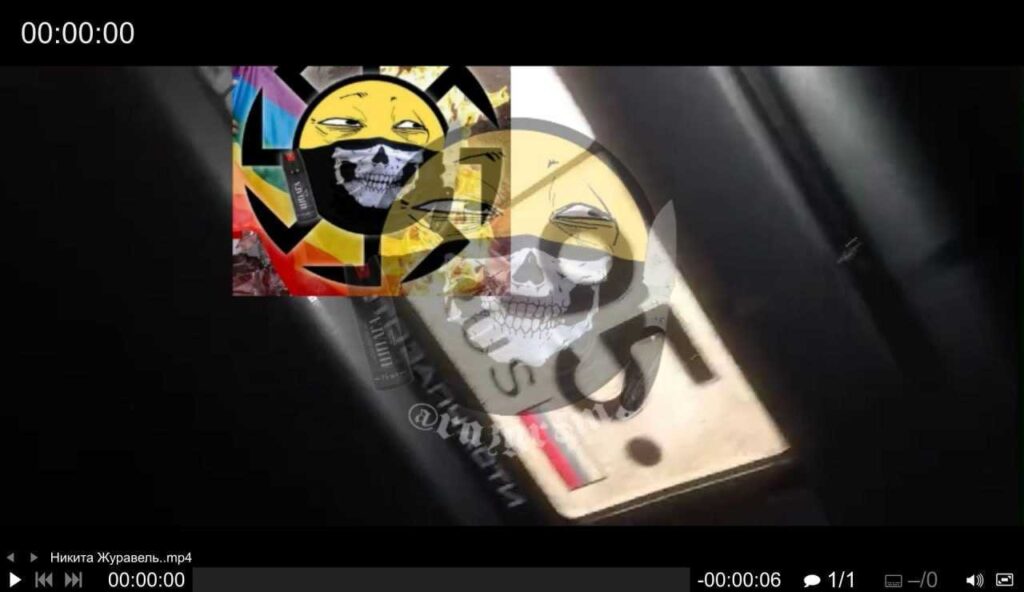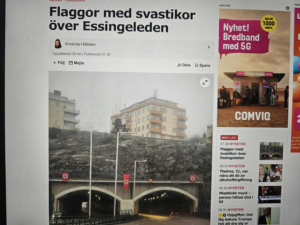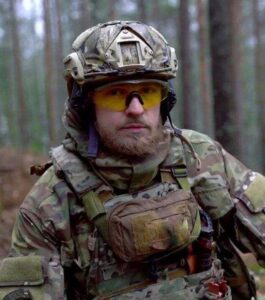A new generation of far-rightists has emerged in Russia, attacking migrants against the backdrop of the invasion of Ukraine, filming their attacks on video and publishing them on Telegram. Gennady, a participant in the Nazi Video Monitoring Project (NVMP), a project to monitor videos of attacks neo-nazis have published themselves, told Antifascist Europe how Nazi skinheads have returned to Russia, what their attitude to the war in Ukraine is, and how the media influences neo-Nazi content.
How did the idea of NVMP come about in the first place?
In the summer of 2023, the number of attack videos in far-right channels on the messenger Telegram increased dramatically. Earlier, attack videos were released monthly; now, they publish new videos weekly. It became clear that a new socio-political phenomenon was taking shape, so we came up with the idea of counting these videos so that we could operate with concrete figures that researchers, human rights activists, and journalists could refer to.
When we started the project, we realized that the bulk of the attacks were committed by a new generation of far-right activists who had not previously been present in Russia. At first, they were pepper spraying passers-by, which is the most common type of far-right video content. However, thanks to our monitoring, we can see that the size of neo-Nazi groups and the brutality of their actions are growing.
Can you describe what the typical far-right protagonist of these videos is like?
It is a very young person who is driven by hatred. It’s a teenage rejection of the world around them, which has found a radical form of expression in far-right aesthetics and violence. The realization of violence allows teenagers to feel their power because, in everyday life, they are deprived of it – even power over themselves. After all, he has parents. A lot of gibberish is going on in his head, mostly just a desire to shock society. That’s why the far-right is often interested in murder, dismemberment, maniacs, and other extreme forms of violence. He looks like a typical skinhead from the 90s: shaved head, bomber jacket, and heavy boots. The only difference in style is that white shoelaces now mean nothing – whereas before, they had to be earned by committing murder.
In the 90s, the driver of the Nazi skinhead subculture in Russia was the far-right music scene, which imported Western practices. This is not the case now. Why have Nazi skinheads returned to Russia?
There are still far-right bands in Russia, but music has ceased to play a fundamental organizing role in the neo-Nazi subculture. As for the second half of the 2000s, football fans also played a massive role in the far-right milieu, but now they have faded into the background due to the introduction of Fan ID. Online channels with violence and other banned content, which far-right bloggers often run, are much more important to the subculture today. Of course, to a certain extent, the war in Ukraine has influenced the emergence of Nazi skinheads. The fascist subculture is usually always associated with militarism and nationalism. Both have abounded in the last few years. Now, Russian society lives with the feeling of an approaching war of all against all.
How has the war in Ukraine influenced the emergence of a new generation of the far-right in Russia?
Firstly, the war caused a massive explosion of nationalism in Russia. However, this is a common story for war, as nationalism becomes an essential propaganda tool that states on both sides actively use to mobilize the population.
Secondly, the visibility of the far-right has increased dramatically due to their active participation in the war. We know that the far right is actively involved on both sides of the front in the conflict. Compared to the regular army, their number might not be so large. Still, they are the most visible, have the most developed media machines that are engaged in war propaganda, raise money through volunteers, and at the same time promote far-right values and form the corresponding environment.
Thirdly, at the behest of the nationalists, who have strengthened their position in the media, a large-scale anti-migrant campaign was launched in Russia at the end of 2022. Roughly speaking, when news from the war front stopped reaching the audience, the far-right media returned to their standard agenda of “migrant mayhem.” The far-right found influential patrons in the form of functionaries from the law enforcement bloc who needed to show their importance. As a result, the entire year of 2023 inside Russia was spent under the aegis of the fight against migrants. And official statistics directly indicate that migrants commit fewer crimes. However, as a result, far-right projects have emerged that specialize in publishing negative news about crimes allegedly committed by migrants. Hatred towards migrants is one of the essential prerequisites for the formation of a far-right environment among teenagers, as they spend more time on the Internet, where they consume this propaganda, and on the street, where they feel the danger of street violence.
What age are we talking about?
Literally from the age of 13 to 20. The average age is 15-17. This is partly a demographic phenomenon: five years ago, there were significantly fewer teenagers in Russia because of the demographic pit of the 1990s. And now there are considerably more teenagers in Russia because they were born in the mid-2000s, when the birth rate peaked. Some of these teenagers have re-formed a far-right subculture. They are now in the most active phase of growing up, during the years of war in Ukraine. They came out of the age of a child and began to immerse themselves in the adult world against the backdrop of the war.
A previous far-right generation ended in the early 2010s. How is this new generation of the far-right different?
The neo-Nazis of the late 90s and early 2000s were primarily a street subculture. These teenagers hung out together on the street and then got on the internet. The new generation of the far-right are the Zoomers, who grew up online and have only now hit the street. From this follows a significant difference: the latest generation of neo-Nazis has no big guys. In the past, big guys in such groups always passed on experience and relevant practices, such as making sure that someone did not undeservedly wear white shoelaces.
In other words, is the new generation of neo-Nazis acting spontaneously, with no one controlling it?
So far, it looks more like an Internet subculture with a set of aesthetic sympathies, common symbolism, a form of leisure in the form of attacks, and an excessive interest in violence. So, we can talk about the emergence of a new generation of far-right subculture in Russia. I would not yet call it a movement, as this requires more organized forms.
It turns out that the NRMP does not affect those loyal to the authorities, that is, the so-called systemic nationalists, who are older.
This teenage far-right culture is a reaction to larger processes in Russian society. These violent kids who engage in street violence don’t make up the picture, but they are an expression of a social process that is taking more explicit forms before our eyes. That is, roughly speaking, older nationalists engaged in inciting national discord in the media, and the far-right teenage subculture, fuelled by this hatred, immediately moves to some kind of action.
A recent report by Russia’s oldest monitoring center, Sova, also speaks of the emergence of a new generation of far-right activists, but it stresses that their attitude to the events in Ukraine is unknown. Do you agree with this?
If we take the key channels distributing the video, there is a clear pro-Ukrainian stance. On the one hand, they do not accept hatred towards Russians. On the other hand, they support the idea of the brotherhood of all white people and first of all, Slavs. They consider Putin’s regime as the main culprit of discord between them. This protest subculture is formed through the denial of the existing regime and the desire for an eschatological RaHoWa. Despite the war, the Russian far-right is on good terms with the far-right from Belarus and Ukraine. Occasionally, clips from these two states, as well as from the Baltic states and Georgia, appear on Russian channels.
Why do far-right activists publish their content on Telegram?
The fact that Telegram is a safe platform for the far-right in Russia, Western Europe, and the United States is a long-known fact. This is the principled position of Telegram’s founder, Russian IT entrepreneur Pavel Durov, a well-known libertarian who only bans channels with extremist content under tremendous pressure. The messenger’s rules prohibit the distribution of calls for violence and violent videos in open channels, but this rule does not work in closed groups. Thus, Telegram has become a platform for a far-right environment that is entirely built around the aestheticization of violence. On Telegram, a full-fledged far-right subculture was formed, which functions in the environment of closed channels. It should also be noted that the Russian authorities banned Meta’s social networks, after which Telegram’s audience began to grow, not only as a messenger but as a platform for distributing news and content.
In the West, deplatforming has become a very effective anti-fascist tactic. Have you tried contacting the messenger administration and demanding illegal content removal?
We have not tried to contact the Telegram administration, as moderators do not, in principle, pay attention to individual complaints. Even if a single person tags blatantly racist content and sends a complaint, usually nothing at all follows. Before Telegram, the key social network in Russia was VKontakte, which Durov also developed. But VKontakte now has an extremely strict policy on political content in general, especially extremist content.
Russia’s most famous neo-Nazi, Maxim “Tesak” Martsinkevich, began his career as a video blogger, starting a whole genre of neo-Nazi vlogs. Why is video so important to the far right?
Social media works by evoking emotions. Video is a much more emotional form of media and has a much more significant impact than photos or text. Violent videos are highly sought after on Telegram because of the lack of moderation. For neo-Nazis, it’s part of a direct action strategy where you don’t just carry out an attack, but turn an act of violence into propaganda. The effect will be much less if such an action is not videotaped and disseminated on the Internet. They constantly emphasize this and call for their attacks to be filmed. This plays to our advantage as well. NVMP provides insight into the dynamics within the far-right milieu and allows us to establish specific trends: what tactics neo-Nazis use for attacks, the characteristics by which they choose their victims, the age of the people who take part in these attacks, their group affiliation, and so on.

How many far-right media channels are we talking about?
We have been running our database since September 2023, with 469 attacks. If we remove the minor cases – wheel slashing and pepper spraying – we are left with 319 attacks. We found most of these videos on the three or four biggest channels specializing in distributing such content. The groups that carry out the attacks also start their channels, but they are much smaller, less frequently updated, and quickly shut down when members are caught. There are about a couple of dozen of them.
The NVMP’s work is devoted to establishing the location of the hate crime. Why is it essential to establish the exact location of the attack?
The most important part of our project is creating a social fact, which we form from dozens of videos and present to the public. We don’t primarily work with the police, but with the media. Usually the far-right themselves do not say in which city the attack took place. Now, they have already started to blur the details of the environment, which makes it harder to establish the location of the attack. The idea of establishing the area was important precisely because, for the regional media, a racist attack is an important news story. So when the video of the attack on the street sweeper comes out, and we realize that it happened in Novosibirsk, we can send out this information to the Novosibirsk media, which publishes this. This helps raise awareness in the community about racist violence. The police have to respond to public outrage because, for the most part, Russians react very negatively to such violence. It is important to note that we publish screenshots, not the video of the attacks themselves, so as not to spread neo-Nazi propaganda, and we use software to blur the watermarks of neo-Nazi channels so as not to increase their audience.
Were there any actual cases that led to legal consequences?
For example, there was a group of teenagers who filmed attacks on street sweepers in St. Petersburg. And they filmed four attacks in one week. We quickly identified the neighborhood where the attacks took place because one of the victims was wearing a uniform with the name of the utility management company. There was a big scandal because ordinary people understand that janitors are very important people who produce tangible benefits, unlike some stupid teenagers who do nothing useful. This usually results in powerful condemnations on social media and a media scandal. These teens were quickly apprehended, and criminal charges were brought against them. In particular, there was the story of the attack on the CPRF member in Rybinsk. It shot well precisely because the victim of the attack contacted us and told the whole story. It led to a significant resonance in the media and, in turn, to a criminal case and the deactivation of this group.
We see in their chats that they are discussing our work. In many ways, they have started blurring videos because of our project. So we publish news of all neo-Nazi arrests and inform them that they are engaging in dangerous activities that could get them in trouble with the law. NVMP is a tangible deterrent as neo-Nazis realize that they are being watched.








